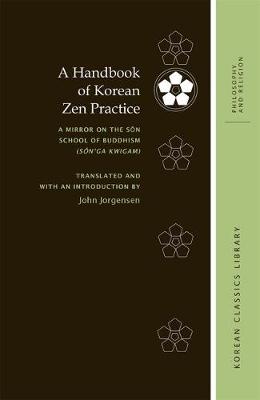
S?n (Japanese Zen) has been the dominant form of Buddhism in Korea from medieval times to the present. A Handbook of Korean Zen Practice: A Mirror on the S?nSchool of Buddhism (S?n’ga kwigam) was the most popular guide for S?n practice and life ever published in Korea and helped restore Buddhism to popularity afterits lowest point in Korean history. It was compiled before 1569 by S?san Hyuj?ng (1520–1604), later famed as the leader of a monk army that helped defend Koreaagainst a massive Japanese invasion in 1592. In addition to succinct quotations from sutras, the text also contained quotations from selected Chinese and Korean works together with Hyuj?ng’s explanations. Because of its brevity and organization, the work proved popular and was reprinted many times in Korea and Japan before 1909. A Handbook of Korean Zen Practice commences with the ineffability of the enlightened state, and after a tour through doctrine and practice it returns to its starting point. Th e doctrinal rationale for practice that leads to enlightenment is based on the Mahayana Awakening of Faith, but the practice Hyuj?ng enjoins readers to undertake is very different: a method of meditation derived from the kongan (Japanese koan) called hwadu (Chinese huatou), or “point of the story,” the story being the kongan. This method was developed by Dahui Zonggao (1089–1163) and was imported into Korea by Chinul (1158–1210). Th e most famous hwadu is the mu (no) answer by Zhaozhou to the question, “Does a dog have a buddha-nature?” Hyuj?ng warns of pitfalls in this practice, such as the delusion that one is alreadyenlightened. A proper understanding of doctrine is required before practicing hwadu. Practice also requires faith and an experienced teacher. Hyuj?ng outlines thespecifics of practice, such as rules of conduct and chanting and mindfulness of the Buddha, and stresses the requirements for living the life of a monk. At the end of the text he returns to the hwadu, the need for a teacher, and hence the importance of lineage. He sketches out the distinctive methods of practice of the chief S?n (Chinese Chan) lineages. His fi nal warning is not to be attached to the text. The version of the text translated here is the earliest and the longest extant. It was “translated” into Korean from Chinese by one of Hyuj?ng’s students to aid Korean readers. The present volume contains a brief history of hwadu practice and theory, a life of Hyuj?ng, and a summary of the text, plus a detailed, annotated translation. It should be of interest to practitioners of meditation and students of East Asian Buddhism and Korean history.
| ISBN: | 9780824840976 |
| Publication date: | 28th February 2015 |
| Author: | John Jorgensen |
| Publisher: | University of Hawai'i Press |
| Format: | Hardback |
| Pagination: | 328 pages |
| Series: | Korean Classics Library: Philosophy and Religion |
| Genres: |
Zen Buddhism |